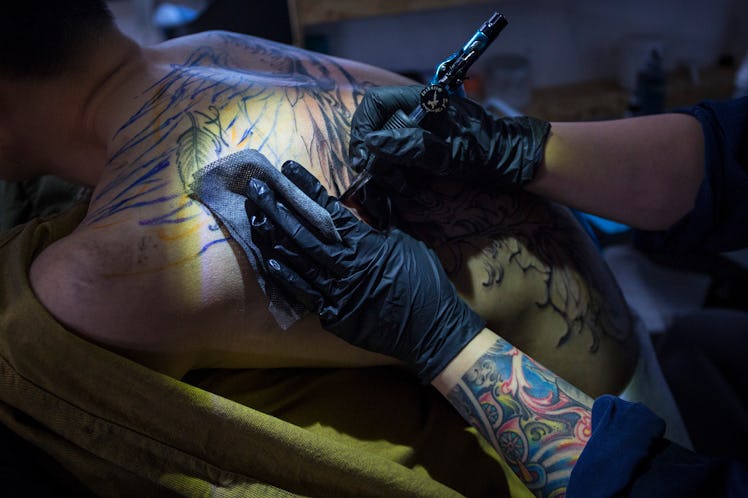
The Most Painful Places To Get A Tattoo Aren't All What You'd Expect, According To Experts
As beautiful as tattoos can be, the truth for most of us is that, unless you have a very high pain tolerance, the process of getting a piece done isn't always fun. I remember when I got my foot tattoo, I squeezed my cousin's hand so tightly to the point where I'm not sure how she didn't lose circulation (and that tat is tiny). Thankfully, it's my favorite tattoo. Small and simple, I love the way it looks when I throw on a pair of pumps. But it got me thinking, if getting my foot done was that bad, then what are the other most painful places to get a tattoo?
According to Mashable, the face, hand, and elbow are among the worst spots, while Reader's Digest suggests the inner wrist and stomach hurt the most. There seems to be a lot of debate here, and to be fair, at the end of the day, it can vary person to person. But to get a better understanding of what areas are the most painful and why, I went to the experts.
Jonathan Valena, otherwise known as JonBoy of Bang Bang Tattoos in New York City, has done work on some of the most iconic superstars of our generation. Everyone from Justin Bieber to Hailey Baldwin to Zayn Malik have been in his chair. Valena is best known for his small, delicate designs, but is well aware that even tiny tattoos can hurt.
"A smaller design, like what I do, is significantly less painful than a larger design with shading, [but] the placement can affect the pain as well," he explains to Elite Daily. "Certain areas of the body are more sensitive naturally, so when they are being tattooed it is slightly more painful. These areas include the ribs, top of the foot, and stomach."
But what exactly makes these areas less tolerable than others? According to Sue Jeiven of East River Tattoo and Darren Rosa of Rising Dragon Tattoo, both located in New York City, the answer is twofold — and it may be more primal than you'd expect.
"What I've found out from research and from myself and just proven overtime is that, [with] anything over a major organ, your body will give signals like 'get away from it,'" Jeiven says. "There’s going to be a lot of nerve endings and there’s going to be a lot of pain censors there because your body is giving a natural signal like stay away from this."
She adds that places like the heart, stomach, and parts of the back can be the most painful as a result. Also, the tattoo artist, who has over 18 years of experience, says that anything over a bone is likely going to hurt as well.
"What you're feeling is the vibration of the machine," Jeiven explains. "When it's a muscle or fat and it doesn't have anything to bounce back against; the pain is minimal — your body absorbs it. But if it's bone underneath, as you're tattooing the person, the bone is kind of like bouncing back the pain, so you’re going to feel it almost from both sides."
Rosa, who has over 33 years of tattooing experience, also adds another interesting observation to the mix, and believe it or not, it has to do with sex.
"In general, if something feels good caressed, it would be very painful with a needle running over it," Rosa shares. "One spot that [people] will get done and they’ll be so surprised that it hurts is the buttocks. And the thing is, it’s a highly erogenous zone. It’s near your reproductive organs."
So what can you do if you're dying to get some new ink, but you're terrified of the pain? Jeiven says you can always opt for a numbing agent. But she also notes that you should let the tattoo artist apply it, as most over-the-counter solutions aren't as effective as professional-grade products, and they often don't work on unbroken skin. Rosa adds that since many numbing agents have vasoconstrictors, which constrict blood vessels, the skin can become rubbery. So it's important to go to an experienced artist who knows how to tattoo once the skin texture has changed. But while this option exists, some artists recommend ditching the numbing creams all together and just toughing it out.
"Numbing agents last for a very limited time, only about 10 minutes," Valena explains. "I find it to be best to not start with this, as when it wears off, the pain seems even more intolerable since it wasn't significant at the beginning. Your body's endorphins kick in after a certain amount of time, and you naturally get more used to the process."
But no matter what you do to deal with the pain, you should always avoid being under the influence of alcohol when getting a piece done — and not only because there's a chance you may get a tattoo you'll later regret.
"The number one problem with getting drunk is people are no longer aware," Rosa says, "or as aware of their body movements, and also, their general cooperation is really hampered."
So if you're in the market for some new ink, there's definitely a lot to consider. But the best thing you can do is go to an artist who's experienced and can guide you through the process every step of the way.